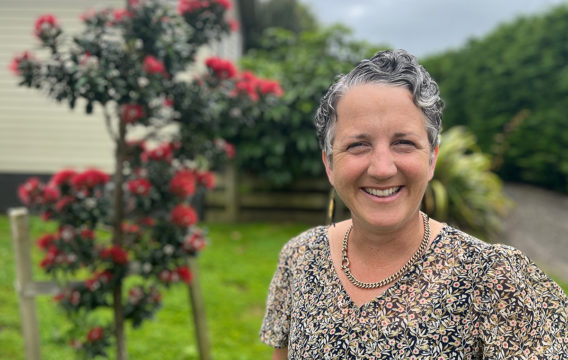
Women Like Us Share Real Menopause Stories: Linda
My name is Linda and I am a menopausal woman. Writing those words still makes me feel rather dumbfounded. It wasn’t very long ago that I hadn’t given menopause a

My name is Linda and I am a menopausal woman. Writing those words still makes me feel rather dumbfounded. It wasn’t very long ago that I hadn’t given menopause a

Meet Clare McCall. She’s the busy CEO of an Auckland-based plumbing company and has over 35 employees working under her. Clare juggles many responsibilities such as taking charge in a

Welcome to ‘real stories’ where Juliet is sharing her personal story of menopause. Australian-based Juliet is 51 and we’ve been supporting her for about 18 months or so. She’s delighted

Turning 50 heralds the beginning of a new life stage for women. It’s the point when our fertile years come to an end, and we move on to the next

At MenoMe® it’s our mission to help support every woman to have her best menopause. This is because the business emerged from our own experiences and we’re women too so

Hi, I’m Jenna from Team MenoMe®. This is my personal story of having no idea what perimenopause was until it hit me like a truck. And then how I navigated

In our Women Like Us – Personal Stories Of Menopause series, Rebecca* and Lyndal* filled out our Q&A form and shared what menopause has meant for them. Rebecca’s* personal story

Other women’s personal stories about menopause can be enormously helpful to our own experiences. There’s a power in knowing we’re not the only ones going through this transition and discovering

Welcome to ‘real stories’ where Emmy is sharing her personal story of menopause. Only 40 when she realised she was experiencing perimenopause, Emmy calls her experience ‘the monster’. A wife

Real Stories of Menopause In our Women Like Us – Real Stories Of Menopause series, we caught up with Jackie Adam to talk about what menopause feels like for her.

Welcome to Women Like Us – where women share their stories of menopause. In this issue of Women Like Us, we’d like to introduce you to Jacq Dwyer (KSM). Index:

May we introduce Alison Smith? Alison’s a busy (especially during the booming 2021 market!) real estate agent in South Taranaki, New Zealand. Originally a dairy farmer, Alison’s been working in

Meet Amy Harris from South Australia. Amy’s story is long as she’s been going through the symptoms of menopause since she was 28. She’s now 54. “I began having problems

Guess what? The age at which a woman starts perimenopause, or the lead-up to menopause is different for everyone. There is no such thing as a ‘perimenopause age’ – we

Vanessa shares: Hi there, my name is Vanessa. I’ve been in menopause for what seems like forever. Since at least 2013. My Symptoms It has been full of ongoing endless

Leigh Kite is the MD (Managing Director) of Team MenoMe. She reflects on her perimenopause journey in this personal account. Now that I’m post-menopause I look back at my younger
At MenoMe®, Menopause is our one & only game®. We live and breathe it – ’cause we’re going through it too or we’ve gone through it, and we totally get it! We’ve got your back and we promise to add a sprinkle of laughter to this rollercoaster ride!
Meno-Me Ltd
Unit 3/10 Makowhai Road,
R.D. 12, Hawera,
New Zealand.
Free call: 0508 MenoMe
Email: info@meno-me.com
Contact us here…
MenoMe®, LotsaLocks®, Merry Peri®, Perky Post®, Happy Go Tummy®, Women on Fire® , Mini Pause® and Menopause is our one & only game® are registered trademarks owned by Meno-Me Limited.
affron® is a registered trademark of Pharmactive Biotech Product, S.L.U.
keraGEN-IV® is a registered trademark of Keraplast Manufacturing.
Livaux® is a registered trademark of Anagenix IP Limited.
This is the time when menstruation is well and truly over, the ovaries have stopped producing high levels of sex hormones and for many ladies, perimenopause symptoms subside.
Estrogen has protective qualities and the diminished levels mean organs such as your brain, heart and bones become more vulnerable. It’s also a key lubricant so your lips may become drier, your joints less supple and your vagina might be drier. In addition, your thyroid, digestion, insulin, cortisol and weight may alter.
At this juncture, a woman might experience an increase in the signs of reduced estrogen but she should have a decrease of perimenopause symptoms. That said, some women will experience symptoms like hot flushes for years or even the rest of their lives.
Peri = ‘near’
Most females begin to experience the symptoms of perimenopause in their mid-forties. Your progesterone levels decline from your mid-30s but it’s generally from around 40 that the rest of your sex hormones begin to follow suit.
Perimenopause is a different experience for every woman and some women may barely notice it. The first indicators are usually changes to the monthly cycle. This means that for some ladies, this can be accompanied by things like sore breasts, mood swings, weight gain around the belly, and fatigue as time goes on.
For those with symptoms it can be a challenging time physically, mentally and emotionally.
Importantly, perimenopause lasts – on average – four to 10 years. The transition is usually a gradual process and many women enter perimenopause without realising.